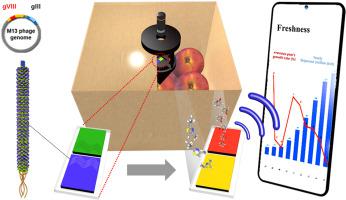Biosensors and Bioelectronics ( IF 10.7 ) Pub Date : 2021-05-16 , DOI: 10.1016/j.bios.2021.113339 Jong-Min Lee , Yujin Lee , Vasanthan Devaraj , Thanh Mien Nguyen , Ye-Ji Kim , You Hwan Kim , Chuntae Kim , Eun Jung Choi , Dong-Wook Han , Jin-Woo Oh

|
Various threats such as explosives, drugs, environmental hormones, and spoiled food manifest themselves with the presence of volatile organic compounds (VOCs) in our environment. In order to recognize and respond to these threats early, the demand for highly sensitive and selective electronic noses is increasing. The M13 bacteriophage-based optoelectronic nose is an excellent candidate to meet all these requirements. However, the phage-based electronic nose is still in its infancy, and strategies that include a systematic approach and development are still essential. Here, we have integrated theoretical and experimental approaches to analyze the correlation between the surface chemistry of genetically engineered phage and the phage-based optoelectronic nose properties. The reactivity of the genetically engineered phage color film to some VOCs were quantitatively analyzed, and the correlation with the binding affinity value calculated by Density-functional theory (DFT) was compared. This demonstrates that phage color films have controllable reactivity through a genetic engineering. We have selected phages that are advantageous in distinguishing each VOCs in this work through hierarchical cluster analysis (HCA). The reason for this difference was verified through the optimized geometry calculated by DFT. Through this, it was confirmed that the tryptophan-based and the Histidine-based of genetically engineered phage film are important in distinguishing the VOCs (Y-hexanolactone, 2-isopropyl-4-methylthiazole, ethanol, acetone, ethyl acetate, and acetaldehyde) used in this work to evaluate the peach freshness quality. This was applied to the design of a field-applied phage-based optoelectronic nose and verified by measuring the freshness of the actual fruit.
中文翻译:

基于M13噬菌体面向人工鼻的可编程表面化学的比色生物传感器阵列的研究,用于挥发性有机化合物的检测:从生物传感器的基本特性到实际应用
爆炸物,毒品,环境激素和变质食物等各种威胁,在我们的环境中均表现为挥发性有机化合物(VOC)。为了及早发现并应对这些威胁,对高度敏感和选择性电子鼻的需求正在增加。基于M13噬菌体的光电鼻非常适合满足所有这些要求。但是,基于噬菌体的电子鼻仍处于起步阶段,包括系统化方法和开发在内的策略仍然至关重要。在这里,我们已经集成了理论和实验方法来分析基因工程噬菌体的表面化学与基于噬菌体的光电鼻特性之间的相关性。定量分析了基因工程噬菌体彩色膜对某些VOC的反应性,并比较了与通过密度泛函理论(DFT)计算的结合亲和力值的相关性。这表明通过基因工程,噬菌体有色膜具有可控的反应性。我们选择的噬菌体在通过层次聚类分析(HCA)区分这项工作中的每个VOC方面都非常有利。这种差异的原因已通过DFT计算出的优化几何结构得到了验证。由此证实,遗传工程噬菌体膜的色氨酸基和组氨酸基在区分挥发性有机化合物(Y-己内酯,2-异丙基-4-甲基噻唑,乙醇,丙酮,乙酸乙酯,和乙醛)用于评估桃子的新鲜度。这已应用于现场应用的基于噬菌体的光电鼻设计,并通过测量实际水果的新鲜度进行了验证。































 京公网安备 11010802027423号
京公网安备 11010802027423号